Intel Core i5-8400 Review: Six Cores On A Budget
Why you can trust Tom's Hardware
Final Analysis
Intel's Core i5-8400 is the cheapest modern six-core CPU, if you believe the company's recommended customer price. That's quite the feat, given AMD's competitive Ryzen 5 family. Although the -8400 ships with the Coffee Lake line-up's lowest base clock rate, that frequency is offset by more aggressive Turbo Boost bins. As such, lightly-threaded apps spin up nicely, while parallelized workloads benefit from six physical cores working together.
Given Core i5-8400's pedigree, most of us are probably here to learn more about the chip's gaming alacrity. We plotted its performance using average frame rates and a geometric mean of the 99th percentile frame times (a good indicator of smoothness), which we convert into an FPS measurement.
Newer titles are often optimized to extract more performance from CPUs with more than four cores. Our suite includes six games released in 2016 and five older titles that launched in 2014/2015. So, curious whether the latest Intel and AMD many-core processors contribute affect frame rates in a positive way, we're including a chart that breaks out the newer games on their own.
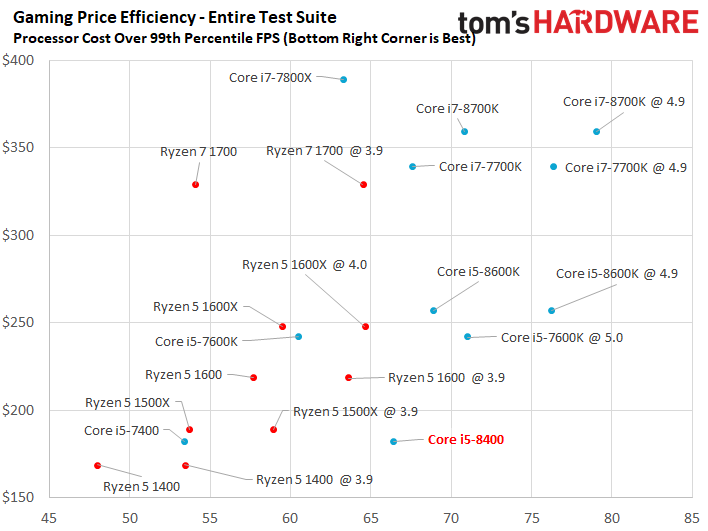
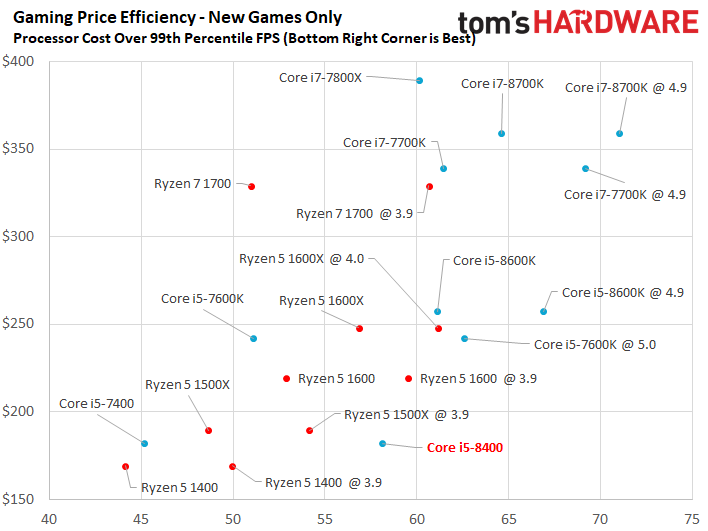
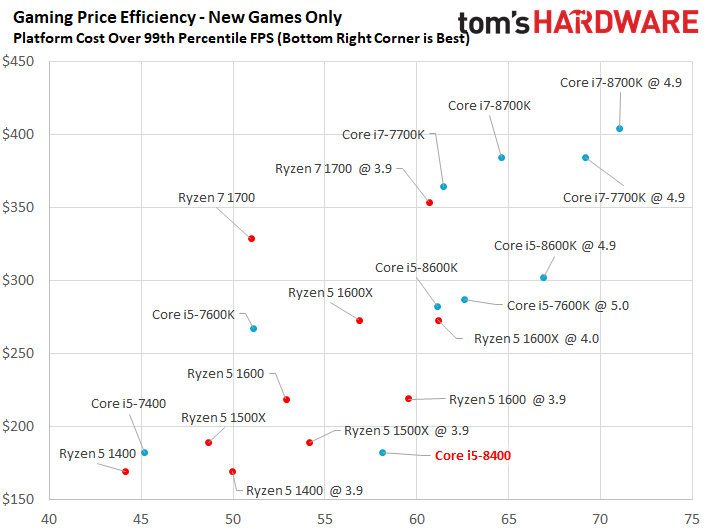

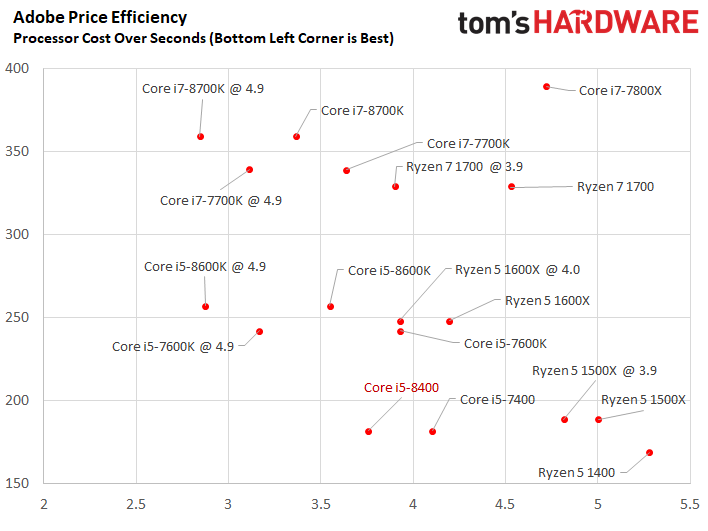
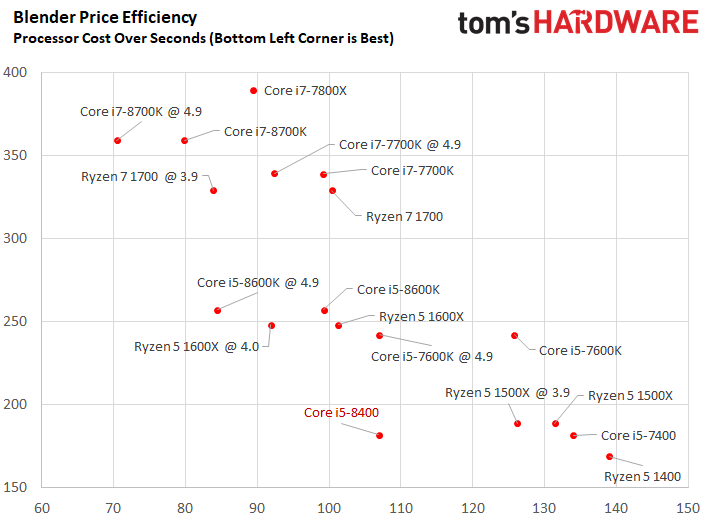
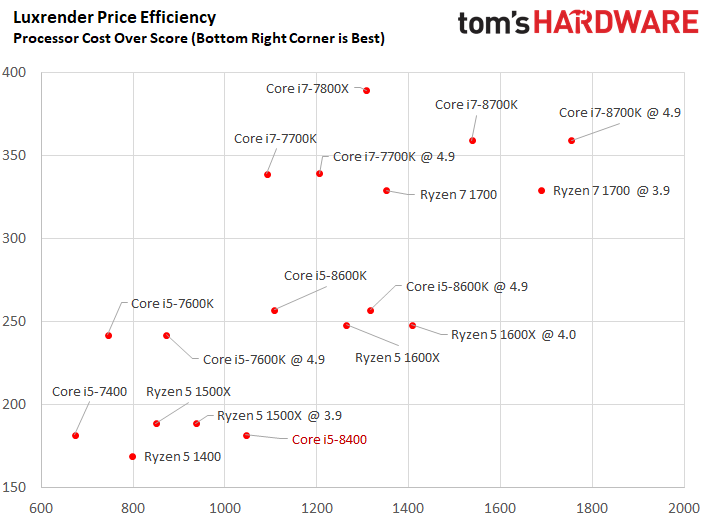
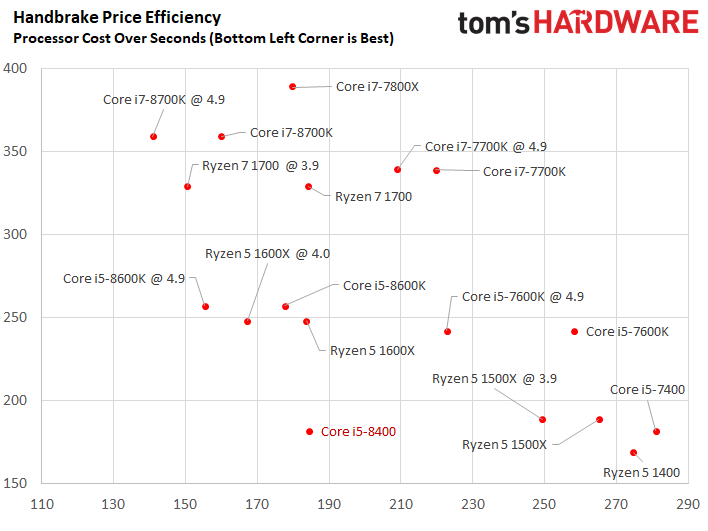
CPUs below the $200 threshold are our key focus, and in its price class, Intel's Core i5-8400 provides the best gaming performance in spite of its locked multiplier. Even when we include a stock ~$215 Ryzen 5 1600, the Core i5-8400 holds its lead. It's only after shining a spotlight on the newer games using an overclocked 1600 that AMD carves out an advantage. Then again, processors in this price range are typically paired to mid-range graphics cards (rather than GeForce GTX 1080s), so you might not see much difference between the comparable AMD and Intel chips.
More important, Core i5-8400 wrecks the Core i5-7400. It's also faster than a stock Core i5-7600K. It can't quite match a Core i7-7700K, like the -8600K, but you're still getting a ton of value, given the similar price point as Core i5-7400.
Moving on to the application charts, Core i5-8400 distances itself from other processors in its price class, beating the previous-gen -7600K in threaded workloads as well. That's downright compelling progress from one generation to the next. Of course, stepping up ~$30 and overclocking a Ryzen 5 1600 should get you similar performance as a Ryzen 5 1600X. And in that case, you'll definitely outperform the Core i5 in heavily-threaded workloads. The compromise is lower performance in lightly-threaded apps and a higher price tag.
Intel's hasty launch means we're stuck pairing mainstream CPUs to higher-end Z370 motherboards until early next year. That's not a great option when you're dealing with a multiplier-locked CPU. Fortunately, the least-expensive Z370-based platforms sell for a reasonable $120. We're far less enthused about Coffee Lake supply issues causing prices on Core i5-8400 and other models to soar through the roof. Many retailers are selling the -8400 for $200 and higher. Hopefully, Intel can address this issue sooner than later. At least you get a bundled heat sink and fan as a consolation prize.
Get Tom's Hardware's best news and in-depth reviews, straight to your inbox.
Overall, the Core i5-8400 offers incredible value to gamers on a budget, providing you can find the chip selling for Intel's recommended customer price. As supply stabilizes, you should be able to get your hands on an affordable hexa-core CPU that frees up funds for a faster graphics card than you would have purchased before. Balance is a beautiful thing to PC builders, and Coffee Lake delivers in spades.
MORE: Best CPUs
MORE: Intel & AMD Processor Hierarchy
MORE: All CPUs Content

Paul Alcorn is the Editor-in-Chief for Tom's Hardware US. He also writes news and reviews on CPUs, storage, and enterprise hardware.
-
velocityg4 I'd be interested in knowing. Under what circumstances can you get it to hit 3.8Ghz reliably under a 6-core load? That is quite a spread.Reply
If one was to delid the CPU and use a decent CPU cooler. Would it reliably maintain the max turbo boost when the CPU usage demands it? Is the stock heatsink and decent case cooling plenty?
On another note. It is time for the return of the Turbo button. That would be pretty sweet to click the button and manually have the CPU jump between 1, 2, 4 and 6 cores at their respective boost frequencies or down to standard. I know it isn't necessary as it is all automated and that wasn't the purpose of the Turbo button. Some people just like manual control. Plus old time computer geeks would get a kick out of it. -
AgentLozen This is a very neat chip at it's price point. Very little has changed between Kaby Lake and Coffee Lake except for the core count. Luckily for Intel, those added cores make all the difference.Reply
This CPU would sit nicely on a budget system. It's a shame that there are no inexpensive motherboards that it could fit into like the conclusion of this article states.
If you didn't plan to overclock, this is the best CPU on the market for gaming and general productivity. -
The_King We have AMD to thank for all these budget cpu's from Intel, and you all know why! So thank you AMD.Reply -
rwinches No, you can't have charts based on FPS or seconds or related to MSRP. Drivers update, Prices change, Memory Speeds Increase and price lowers, MB prices are wide range.Reply
It is known that Some games work better for AMD when AMD GPUs are used. Game FPS can be dramatically improved by changing just one parameter. Test results that are milliseconds or a few seconds or frames faster are irrelevant and subject to variations in real world use on systems that are not clean installs and have other SW installed and running. -
10tacle Reply20307991 said:No, you can't have charts based on FPS or seconds or related to MSRP. Drivers update, Prices change, Memory Speeds Increase and price lowers, MB prices are wide range.
I don't understand your point. This is a review of the 8400 and comparing it to other CPUs only. Memory, motherboards, and all the other variables are you talking about in a full PC build are irrelevant to this chart comparison. They have to establish a constant standard across the spectrum, and they did so.
20307991 said:It is known that Some games work better for AMD when AMD GPUs are used. Game FPS can be dramatically improved by changing just one parameter. Test results that are milliseconds or a few seconds or frames faster are irrelevant and subject to variations in real world use on systems that are not clean installs and have other SW installed and running.
Again, they are using a single standard across the spectrum comparison. Of course there are infinite combinations of hardware that can game change a little. The bottom line here is that among every major tech review website, all of Intel's chips are better for gaming than Ryzen. The only exception is when dealing with beyond 1080p gaming like QHD or UHD where it's mostly on the GPU. People who buy this chip are the perfect candidate for a 144Hz 1080p G-sync or Freesync monitor.
-
elbert Compared to the Ryzen 1600 with a B350 its $50 higher. That is a higher video card level. IE get the 8400 with a 1050ti the Ryzen budget would get a 1060 3GB. Intel needs their B360 motherboards for the 8100 and 8400 to ever be a budget winner.Reply -
hardwarefox1234 Has the author even bothered to look at the street prices for the CPUs??Reply
Core i5 8400:
https://www.newegg.com/Product/Product.aspx?Item=9SIA7HN6HF3442&cm_re=i5_8400-_-9SIA7HN6HF3442-_-Product
http://www.microcenter.com/product/486090/core_i5-8400_coffee_lake_28_ghz_lga_1151_boxed_processor
http://www.ncixus.com/products/?sku=142465&vpn=BX80684I58400&manufacture=Intel
The lowest price is $249.99!
The Ryzen 5 1600 is much cheaper:
https://www.newegg.com/Product/Product.aspx?Item=N82E16819113435&cm_re=ryzen_5_1600-_-19-113-435-_-Product
http://www.microcenter.com/product/478826/Ryzen_5_1600_32GHz_6_Core_AM4_Boxed_Processor_with_Wraith_Spire_Cooler
http://www.ncixus.com/products/?sku=139481&vpn=YD1600BBAEBOX&manufacture=AMD
https://www.amazon.com/AMD-Processor-Wraith-Cooler-YD1600BBAEBOX/dp/B06XNRQHG4/ref=sr_1_3?s=pc&ie=UTF8&qid=1508952175&sr=1-3&keywords=ryzen+5+1600
Price is $199.99~$219.99!
Then if you add the price of the B350 motherboards,they start at a lower level than the Z370 ones. -
hixbot Why did you label section 10, overclocking, cooling and temperature? There's no overlocking on this chip? I would have like to see at least an attempt at Bclk overlcock with a mobo that has a clock generator.Reply -
TJ Hooker I really wish more reviewers would look at what sort of boost clocks the i5 8400 can sustain under load, with the stock cooler as well as aftermarket. From what I know you could typically assume past Intel CPUs would operate at or near max turbo almost indefinitely, but with a 50% increase in core count and such an unusually wide gap between base and boost clocks (not unlike their mobile CPUs), I'm curious how Coffee Lake will behave in that regard.Reply